Subscribe
Get weekly recipe updates
sent to your inbox!


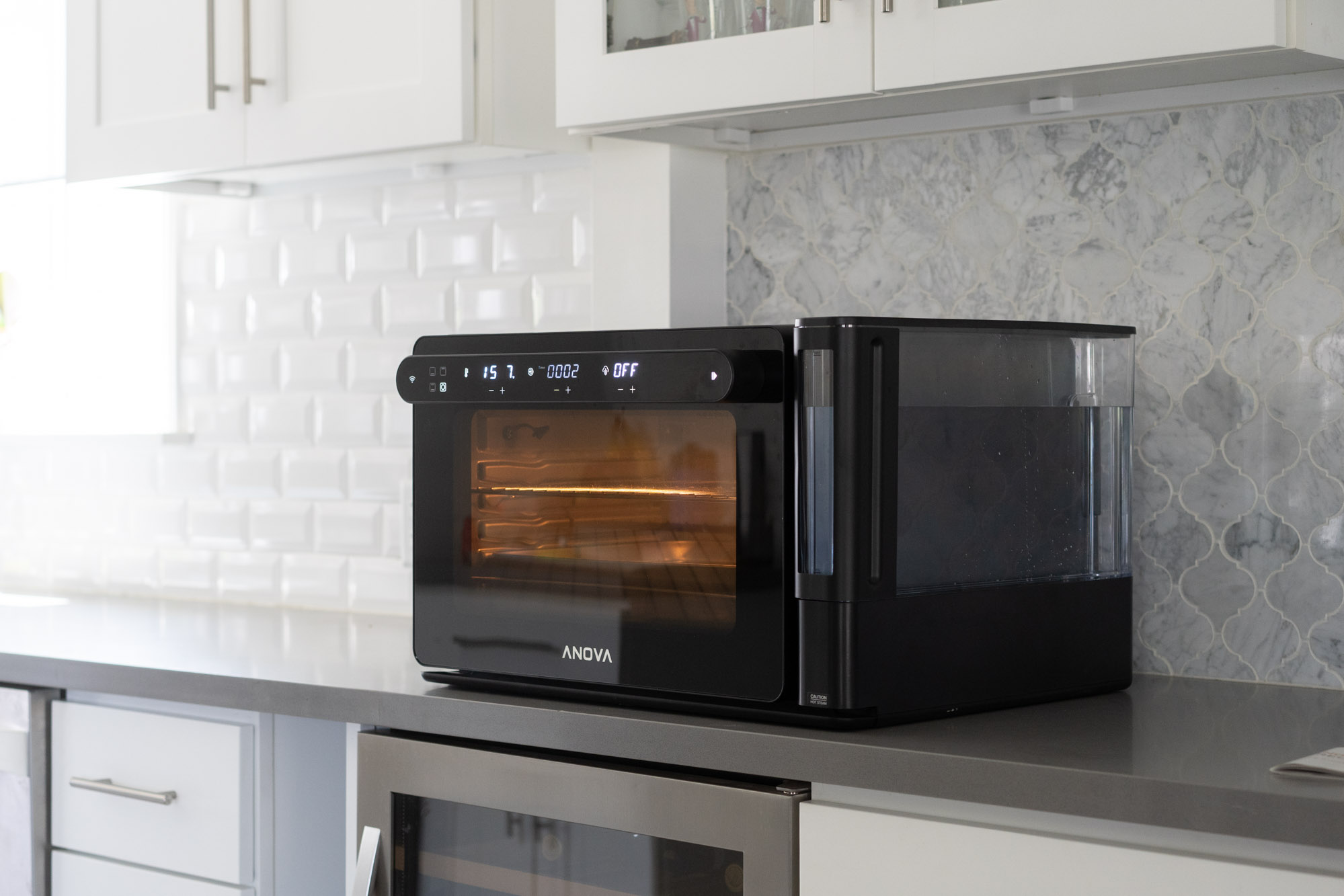
Anova Culinary hit it big with the company’s smartphone-connected Sous Vide Precision Cooker, and in 2020, Anova introduced its combi steam oven, the Precision Oven, also a smart appliance conjoined with the sous vide cooker by the Anova Culinary app. Since its release, the APO (as it’s called) has racked up glowing reviews, so I tested it for a week to see if it lived up to all the hype.
The combi oven – combination of a convection oven and a steam oven – was first invented for the food-service industry for the purpose of producing many racks of food all perfectly cooked in the exact same way. The combi oven can be programmed for dry or moist heat and can automatically shift between the two during the cooking process.
The convection of a combi oven produces precise, dry heat, and the added steam function allows for control over the moisture level of foods. Basically, the combi oven can cook just about anything: sous vide a steak to medium-rare, steam rice, proof and bake a baguette, air-fry crispy French fries, roast a succulent chicken.
Restaurant combi ovens are huge and hugely expensive. The first home combi ovens were mostly built-ins and were also very high-end.
Anova’s countertop model was the first of its kind, and although it’s not as expensive as its plus-size cousins, it’s still a hefty $599. There were multiple reports that the APO really wasn’t up to snuff, and to Anova’s credit, Anova responded to critics by updating the software in 2020 and again in 2021. The integrated app – which during my testing was absolutely essential – is continually updated with recipes and instruction videos.
The science behind the APO is based on modulated temperature control and using steam as a means for preventing food from drying out as it can in a traditional oven.
The thermostat of a traditional oven can often be finicky, and the oven’s temperature can vary 25 degrees (or more) hotter or cooler. Unless you take the time to calibrate your oven’s thermostat, it’s pretty impossible to get consistent results.
The APO uses a PID (proportional-integral-derivative) controller that corrects a failure in a particular control function. Multiple temperature sensors and a microprocessor control temperature. So when the sensors pick up an increase or decrease in temperature, the PID controller makes the adjustment to maintain the temperature programmed.
The natural moisture in food can be leached out by the dry heat of a traditional oven. Meaning your food is more likely to dehydrate in a regular oven. But the APO has an integrated water tank that generates steam inside the oven. This creates plenty of humidity which surrounds and clings to what’s being cooked, so the food’s internal moisture doesn’t evaporate.
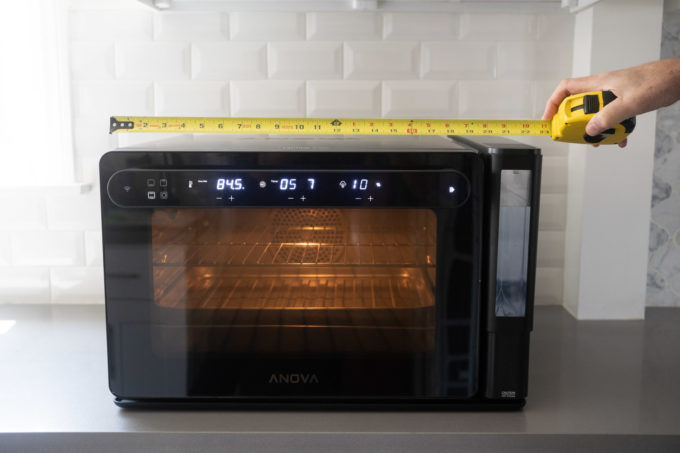
The APO is a lot larger than I thought it would be and at 46 pounds, a lot heavier. As I unboxed this behemoth, I found separate detailed instructions for how to lift it out of the packaging with the warning that it’s a two-person job.
Anova takes pains to promote the oven as attractive, but it’s really a bulky black box with a water tank. The water tank holds 1.3 gallons, adding to the oven’s weight. So when you decide which counter real estate you’ll sacrifice for the APO, it’s not going to be moved – without the help of that second person.
With the water tank installed (using distilled water only!), the oven measures 23 inches in length, 18 inches tall, and including the oven’s large handle, 20 inches deep. The interior measures 1.2 cubic feet, which Anova claims can hold a 8-11 pound turkey (10 pounds is their recommendation).
This countertop oven comes with two racks, a stainless-steel pan, and a food probe thermometer for the sous vide function. The food probe has a 4.4-inch metal wand attached to a 19-inch cable, which plugs into the upper left interior of the oven. It has top, back, and bottom heating elements and a steam boiler.
The handle doubles as the oven’s programming center. Once the oven is plugged in, a touch screen panel illuminates. One of the baffling things about the oven’s design is it doesn’t have a power on/off button. According to the skimpy user guide – and the website – the only way to turn the APO off is to let it cool and pull out the plug.
Once I had the oven set up, I downloaded the Anova app (which they have for iOS and Android). There are two – the Anova Oven app and the Anova Culinary app. The Anova Culinary app is just for the standalone Anova sous vide device, so don’t bother downloading it for this oven.
The app has several promotional videos – called “About Your Oven” – in which an annoying actress explains what the oven can do. Mind you, these are not instructional videos; in fact, there are no instructional videos at all on the app or on Anova’s website.
All you get is a tiny pamphlet that goes through the basic functions, how to clean the oven, how to descale the water tank, and how to replace the oven’s light bulb. Nothing else. So I had to wing it and watched several YouTube videos to at least get a sense of how the oven works.
Next, it was time to link the APO with my smartphone. Anova really pushes its Wi-Fi connectivity as a major accomplishment. Linking is done through the app, and it should have been a process as easy as 1-2-3. But after an hour and a dozen attempts and troubleshooting, I never got it to connect. The app finds and connects to the network, but the oven doesn’t connect to the app. (Even as I’m writing this review, I tried it a couple more times, and nope, no connection.)
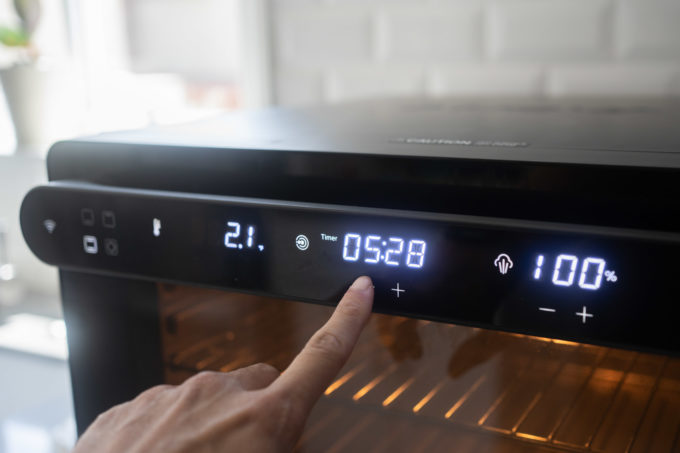
When the APO is plugged in, the touchscreen chimes and lights up. It has four icons for the heating elements – lower, upper, lower and upper, and rear. Next to the icons is a thermometer icon for selecting the sous vide mode, and beside it, is the temperature setting, which is defaulted at 66° Celsius, with plus and minus signs – for adjusting the temperature – beneath.
Herein lies my first issue. All the recipes on the app and online are in Celsius only. If you prefer to cook in Fahrenheit, then you need to make the conversion yourself. But if you want to switch the oven from Celsius to Fahrenheit, you need to hold the thermometer icon for 5 seconds. (I had to search the documentation to figure this out.)
Honestly, Anova could have made this easier by programming the thermometer icon for one or two taps.
Next to the temperature is a target icon, which controls the timer and the probe temperature, which can be programmed separately, depending on the cooking mode. I have no explanation why these two controls are linked, but it was unnecessarily confusing when I was programming the sous vide mode. The machine’s interface does allow for precise temperature control.
The next control is for turning on/off the steam and at what percentage of steam to be produced.
Finally, on the far right of the handle is a play/pause icon for starting/stopping the oven program. Remember, this is in lieu of a proper on/off button.
I decided to test the APO in all of its advertised capacities: defrosting, sous vide, air fry, rice cooking, steaming, proofing and baking.
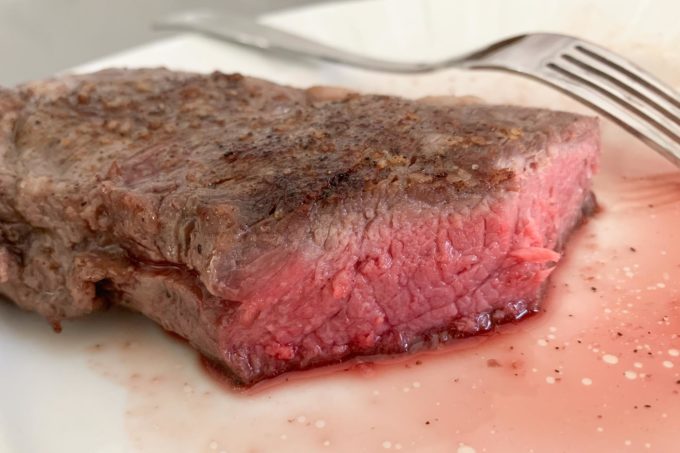
I was most curious about the APO’s sous-vide function since the food does not need to be vacuum-sealed in an airtight bag or cooked in a controlled-temperature water bath. Following the app’s recipe for “Steak 101,” I salted a 1-pound, 1-inch-thick New York strip steak and inserted the probe into the thickest part of the steak. I then set the steak on the included stainless-steel pan and connected the probe to the oven.
Simple enough, but then came 20 minutes of trying to figure out how to program the APO. All the recipes assume that you know how to work every detail of every function, so I found no help on the app. I just started pushing buttons until I found what the recipe directed: sous vide mode, steam 100%, temperature 60℃ (or 140℉), and probe target 51℃ (or 123.8℉).
In a traditional sous vide cooker, a steak can take up to 2 hours to be cooked. To my amazement, my steak hit the target temperature in only 32 minutes. As with any sous vide steak, it should be patted dry and then seared – unless you actually want a gray slab of beef – in a cast-iron skillet. I was skeptical that the steak was fully cooked, but when I cut into it, the steak was a beautiful medium-rare, juicy, and tasty.
So, for the APO’s sous vide function, definitely a success.
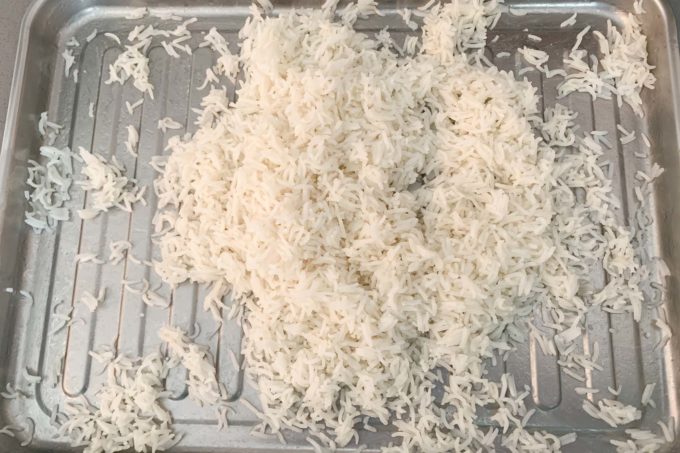
Following the app’s “Rice 101” recipe, I combined 2 dry-measuring cups of rice, 3 liquid-measuring cups of water, a teaspoon of olive oil, and a ¼ teaspoon of salt in the oven’s sheet pan, and spread it all out in an even layer. The rice is then steamed at 100% steam capacity, using the convection heating element, for 30 minutes.
I was again frustrated by the recipe’s instructions for programming the oven’s temperature to 100.6℃ because there’s no way to input .6 – only .0. I rounded it off to 101℃ and crossed my fingers I’d still get “perfectly fluffy rice” with this “foolproof method.”
I checked the rice after 24 minutes – it needed one more minute – and fluffed it with a fork. It was perfectly cooked, but I’d get the same results in a rice cooker or saucepan with a lot less hassle.
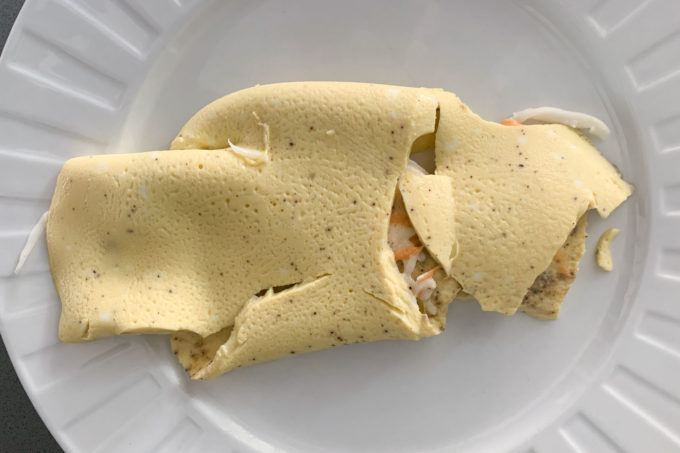
The “Omelet 101” recipe calls for eggs, milk, and salt, blended and poured into a buttered pie plate or nonstick skillet, which is what I used. The first step is to preheat the APO with the sous vide and steam functions to 83℃ (181.4℉). It took the oven 10 minutes to hit the temperature – in the same amount of time, I could have already cooked two omelets in a skillet – and then pop it into the APO for 5 minutes.
At this point in my testing, I noticed the temperature fluctuating two degrees. The Anova website claims this is normal, but in my subsequent testing, the temperature substantially dipped or increased during cooking. So much for Anova’s “Precision” trademark–it was very difficult to maintain temperature accuracy.
After 5 minutes, I added cheese and salsa, and cooked the omelet for 30 seconds to melt the cheese (per the recipe). As I was folding the omelet, I noticed that it had a weird texture and appearance, like it was a custard. I’m pretty good at plating, but this thing turned out a mess.
This recipe was a complete failure. The combination of the steam and sous vide made it rubbery and chalky-tasting – like airplane food in the 1980s – and it took way too long to cook.
Neither the app nor the website have any information about defrosting meat. After researching online, I found a Reddit thread that suggested using the sous vide function and the lowest temperature, which is 77℉. I had 1-¼ pounds of chicken thighs frozen together into a solid oval, and after 45 minutes in the APO, I could separate them. In another 15 minutes, the chicken thighs were defrosted.
I prefer the warm water method – meat in a sealed plastic bag, bobbed in a water bath – which takes 30-40 minutes. The APO took a little longer, but results were good.
You could probably defrost an entire frozen, cut-up chicken in about the same time. There’s no hard data on how long it would take in the APO, so you’ll need to keep an eye on the bird throughout the defrosting process.
This was one of the easiest recipes and gave great results. Directions called for inserting a wire rack into the foil-lined baking sheet, but since the included racks don’t fit, I made do. I inserted one included rack into the baking sheet, then balanced the baking sheet on the second included rack.
The chicken wings were tossed in rice flour, baking powder, and Kosher salt, spread on the rack, and cooked at 225℃ (437℉) with the top and bottom heating elements. I was alarmed by the billows of steam emitting from the bottom of the oven, but this was just normal venting.
The recipe called for 25 minutes, but I manually checked the wings at 22 minutes, and they were fully cooked. The wings were extra-crispy and crunchy with tender meat. Absolutely delicious. Next I’ll have to try a whole roast chicken and something more delicate like a cut of salmon.
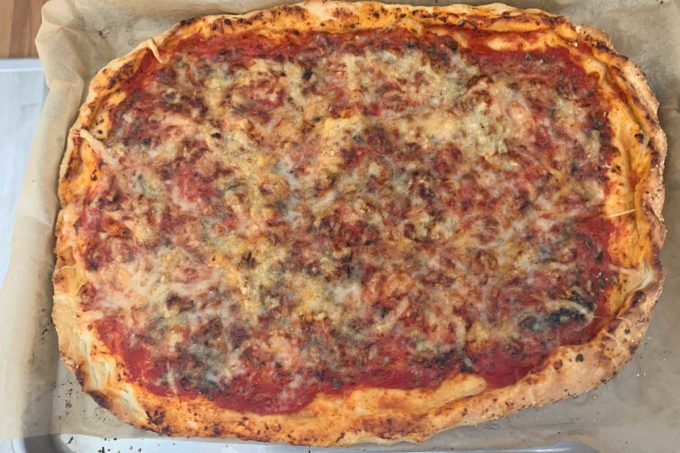
Oddly, the Anova website has instructions for proofing bread dough in the Anova sous vide cooker but none in the APO. I searched online for the method recommended by other combi ovens and landed on 85℉ with 60% steam. I made a simple pizza dough recipe (not the ridiculously complex recipe on the Anova app) and let it proof for 30 minutes. Nothing seemed to be happening, so I increased the steam to 75%.
As I mentioned earlier, the APO’s temperature fluctuates, and throughout the hour-long proofing, it increased to 89℉. The dough, however, wasn’t affected, and it rose well.
I spread out the dough in the baking pan and topped it simply with tomato puree, basil, oregano, and shredded Parmesan. Per the Anova recipe, I preheated the oven to 250℃ (482℉), and as directed, baked the pizza for 7 minutes, using the top and rear heating elements. As it baked, the APO again fluctuated, decreasing in temperature to 219℃.
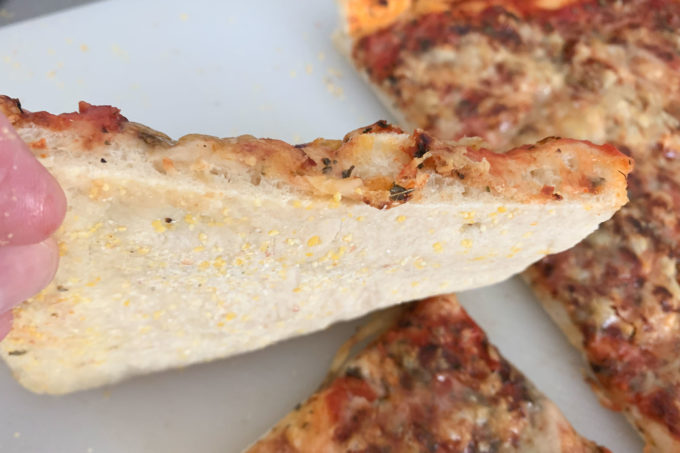
I suspected that the APO wasn’t hot enough and wondered why the recipe didn’t call for the bottom heating element to ensure a crispy bottom crust. I was right on both counts. The top pizza crust was golden and the cheese melted, but the bottom was pale and flaccid and had the texture of freshly baked bread. Better pizza results might be possible. Next time I’ll try a different heat setting using the bottom heating element–not following a recipe from Anova.
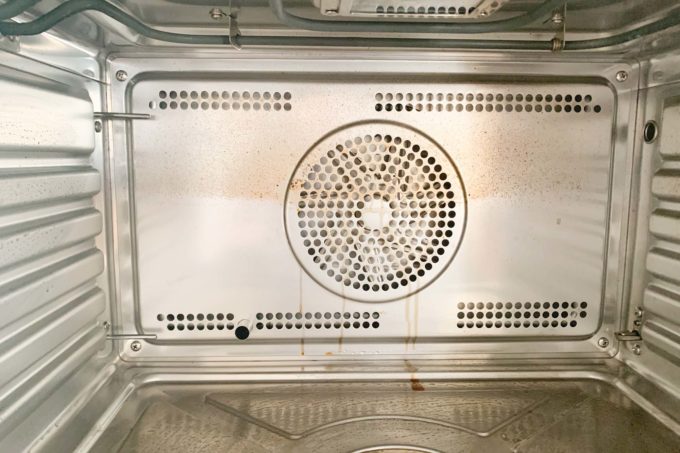
Cleaning the APO is almost identical to cleaning a regular oven. The website instructed preheating the oven to 140℉ with 100% steam, then shutting it off and spraying on oven cleaner. This initial heating with steam didn’t seem to affect the grease in the back of the oven. Anova states that oven cleaner works faster in a warmed oven.
Keep in mind that if you just cooked in the Anova Precision Oven at high temperatures, you may want to cool it down a bit before spraying anything inside it.
Anova then instructs closing the oven door and following the oven cleaner’s time recommendations and then wiping the oven clean. Finally, heat the oven to 300℉ with 100% steam to clear out any fumes. When the oven had cooled, I wiped off the steam, which had picked up a little bit of cleaner I had initially missed.
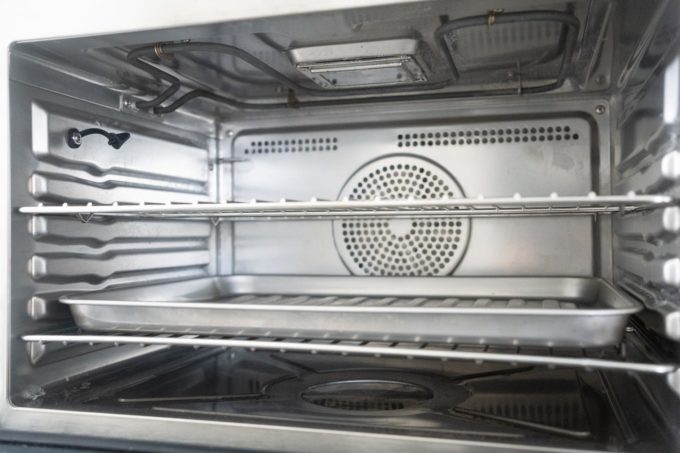
The baking pan and the wire racks are made of a high-grade stainless steel and were easy to clean with a sponge and dish soap.
The Anova Precision Oven’s bagless sous vide function is unique. Anova’s competitors – Wolf, Miele, Cuisinart – have a sous vide function, but you still need to seal the food in a plastic bag before cooking. However, other than that, the APO really isn’t much different from other combi ovens on the market.
Other than a couple of dud recipes on the Anova app, the APO performed well. My major complaint is that Anova doesn’t supply enough information for learning how to operate the oven, and you need to figure it out by trial and error, something not all home chefs may want to do, but hey maybe that’s you!
The APO is definitely not for beginners, and much is made by Anova users that it’s for experienced cooks who have aspirations of being restaurant chefs at home. I’d agree with that assessment to some extent, but Anova might rethink the APO’s engineering so it’s more accessible – and easier to use – for us regular folks.
Anova also needs to work out the APO’s kinks, most critically, its fluctuating temperatures, which is absurd for an appliance that’s heavily marketed as “precision.” The Anova should be adjusted so it’s simpler to toggle between Celsius and Fahrenheit, and an update to the user guide is required.
In theory, the APO could replace many small kitchen appliances, like a sous vide cooker, rice cooker, toaster oven, or an air fryer. For people who can afford the APO – and have the required countertop space – all those devices combined into one appliance is convenient and money well spent.
If you have a small kitchen, I can’t imagine where you would keep the Anova’s Precision Cooker. (Some people online claim they put it on top of their regular oven.) In that regard, individual appliances are a better option, since they can be stored in limited cabinet space.
The bottom line is I don’t think the Anova Precision Oven is for everyone. If you think you’ll plug it in and cook amazing meals from the get-go, you’ll be disappointed. The APO is not intuitive, but if you have the patience to learn how it works and the experience to make adjustments to Anova’s recipes, it could be a rewarding and worthwhile investment.